Unveiling the inner workings of paint spray guns, our paint spray gun parts diagram offers an unparalleled exploration into the intricate components and their harmonious interplay. Join us as we delve into the world of spray painting, empowering you with the knowledge to conquer any painting project with precision and ease.
From understanding the types of spray guns to mastering the assembly process, this guide will equip you with the expertise to maintain and troubleshoot your spray gun, ensuring flawless paint application every time.
Paint Spray Gun Parts Diagram Overview

A paint spray gun parts diagram is a detailed illustration that identifies and labels the various components of a paint spray gun. It serves as an essential reference tool for understanding the gun’s construction, assembly, maintenance, and troubleshooting.
Different types of paint spray guns have unique configurations and components. Common types include:
- Conventional spray guns: Utilize compressed air to atomize the paint and propel it towards the surface.
- HVLP (High Volume Low Pressure) spray guns: Employ a higher volume of air at lower pressure to create a wider spray pattern with reduced overspray.
- LVLP (Low Volume Low Pressure) spray guns: Operate with even lower air pressure and volume, resulting in finer atomization and less paint consumption.
Corresponding Parts
The parts of a paint spray gun vary depending on its type, but typically include:
- Air cap: Directs and shapes the spray pattern.
- Fluid tip: Controls the flow and atomization of the paint.
- Needle: Regulates the amount of paint released from the fluid tip.
- Air valve: Controls the airflow through the gun.
- Fluid valve: Controls the flow of paint through the gun.
- Handle: Provides a comfortable grip for the operator.
- Trigger: Activates the gun’s spraying mechanism.
Components of a Paint Spray Gun: Paint Spray Gun Parts Diagram
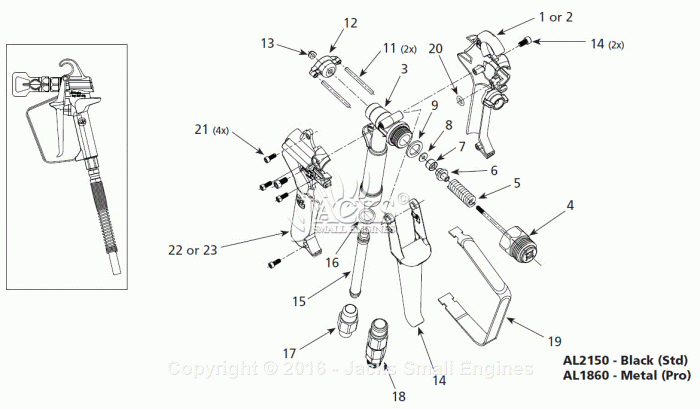
A paint spray gun is a versatile tool that uses compressed air to atomize and propel paint onto a surface. Understanding the components of a paint spray gun is crucial for proper operation and maintenance.
Major Components
The primary components of a paint spray gun include:
-
-*Gun Body
Houses the internal components and provides a grip for the operator.
-*Trigger
Activates the paint flow and controls the amount of paint released.
-*Nozzle
The tip of the gun where the paint is atomized and released.
-*Fluid Tip
Located inside the nozzle, controls the size and shape of the spray pattern.
-*Air Cap
Surrounds the fluid tip and directs the airflow to atomize the paint.
-*Air Line
Connects the gun to the compressed air source.
-*Fluid Line
Carries paint from the reservoir to the fluid tip.
-*Pressure Regulator
Adjusts the air pressure supplied to the gun.
-*Paint Reservoir
Holds the paint and supplies it to the fluid tip.
These components work together to create a controlled and efficient spray pattern, ensuring optimal paint application.
Detailed Diagram and Labeling
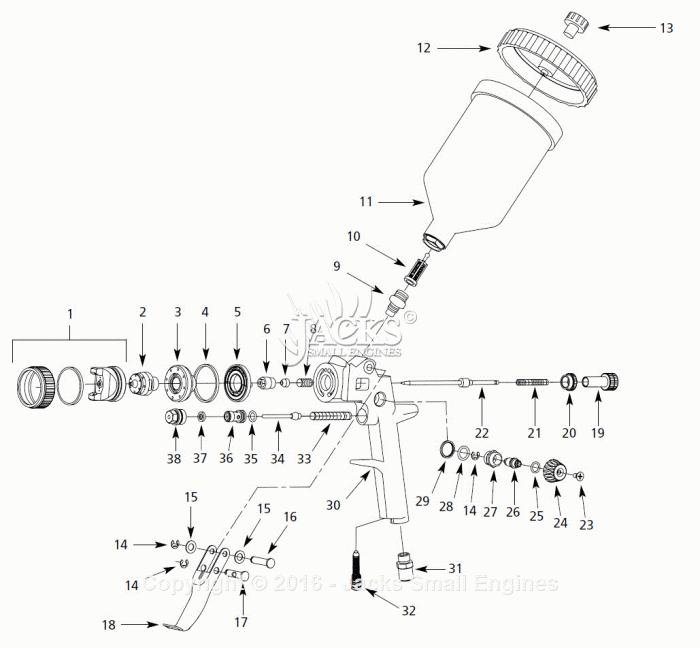
A detailed diagram of a paint spray gun, with each part clearly labeled, can help you understand how the tool works and how to maintain it properly. The diagram below shows the main components of a paint spray gun, including the air cap, fluid nozzle, needle, and trigger.
Paint Spray Gun Parts Diagram
| Part | Description |
|---|---|
| Air cap | The air cap helps to atomize the paint, creating a fine mist that is easy to apply. |
| Fluid nozzle | The fluid nozzle controls the flow of paint from the gun. |
| Needle | The needle opens and closes the fluid nozzle, controlling the flow of paint. |
| Trigger | The trigger is used to start and stop the flow of paint. |
Exploded View and Assembly s
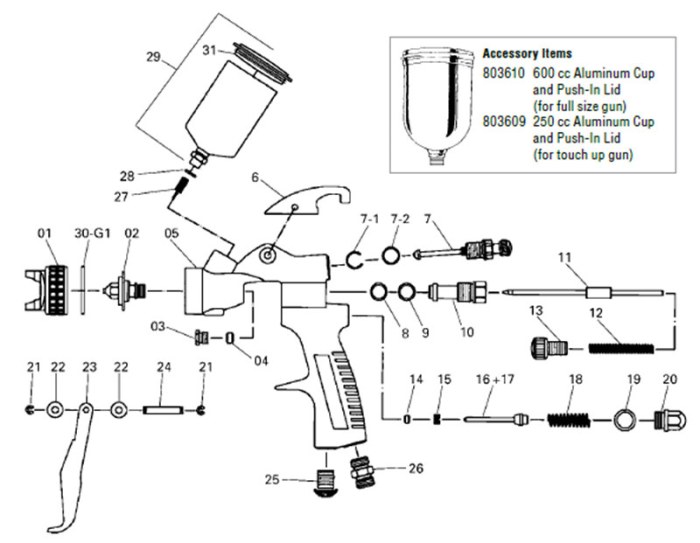
An exploded view offers a comprehensive look at the individual parts of a paint spray gun and their assembly. By understanding the components and their fit, you can easily maintain and repair your spray gun.
Exploded View
[Insert an exploded view diagram of a paint spray gun, clearly labeling each part.]
Assembly s
Follow these steps to assemble your paint spray gun:
- Locate the main body of the spray gun and insert the trigger assembly.
- Attach the air inlet hose to the air inlet port on the gun body.
- Connect the fluid inlet hose to the fluid inlet port.
- Install the nozzle assembly onto the front of the gun body.
- Secure the needle and seat assembly inside the nozzle.
- Attach the spray guard or tip to the nozzle.
- Check all connections and ensure they are tight.
Troubleshooting and Maintenance
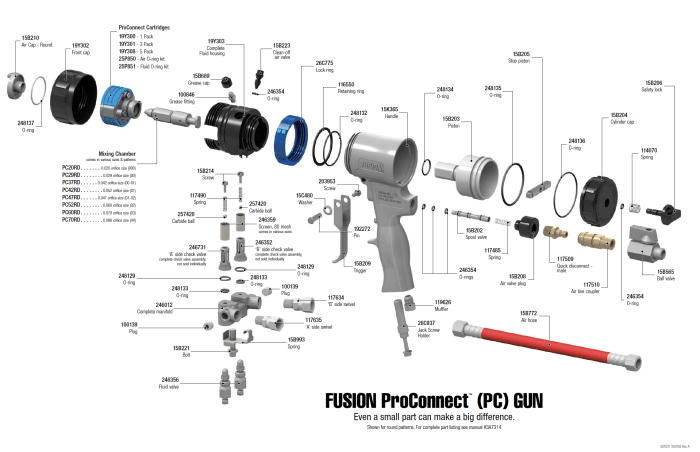
Paint spray guns are complex tools that can occasionally encounter problems. Understanding common issues and their solutions can help you maintain your gun in good working condition. Additionally, regular maintenance is crucial for ensuring optimal performance and longevity.
Common Problems and Solutions
* Clogged Nozzle:A clogged nozzle can prevent paint from flowing smoothly. To fix this, remove the nozzle and clean it with a solvent or compressed air.
You’ll need to understand the ins and outs of your paint spray gun’s parts diagram before you can tackle any repairs or maintenance. If you’re looking for some additional guidance, check out our comprehensive guide to hazwoper 24 hour test answers . Once you’ve brushed up on your knowledge, you’ll be able to get your paint spray gun back in tip-top shape in no time.
Air Leaks
Air leaks can cause uneven spraying or reduced pressure. Check for leaks in the hose, fittings, or gun body and seal them using Teflon tape or a sealant.
Uneven Spray Pattern
An uneven spray pattern can result from a misaligned needle or nozzle. Adjust the needle or nozzle to ensure they are aligned correctly.
Overspray
Excessive overspray can be caused by using too much paint, improper gun technique, or a worn-out nozzle. Reduce paint flow, practice proper spraying techniques, and replace the nozzle if necessary.
Importance of Regular Maintenance
Regular maintenance is essential for keeping your paint spray gun in good working condition and preventing costly repairs. Here are some maintenance tips:* Clean the Gun Regularly:Clean the gun thoroughly after each use to remove paint residue and prevent clogging.
Lubricate Moving Parts
Lubricate all moving parts regularly to ensure smooth operation and prevent wear.
Check for Wear and Tear
Regularly inspect the gun for any signs of wear or damage. Replace worn-out parts promptly.
Store the Gun Properly
Store the gun in a dry and clean place when not in use to prevent rust and damage.
Safety Precautions
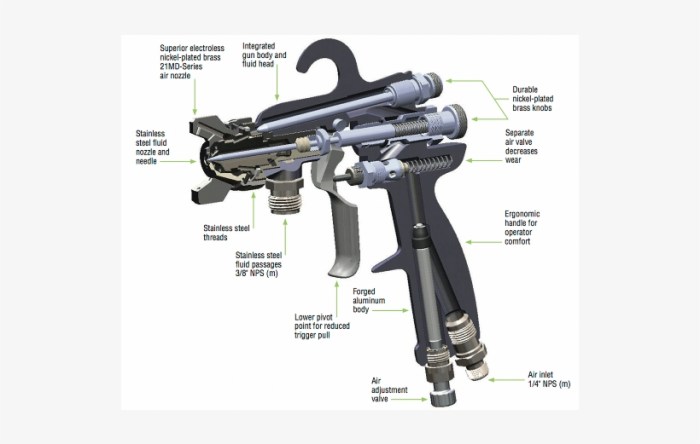
When using a paint spray gun, safety should be your top priority. These powerful tools can create potential hazards if not handled properly. To ensure a safe and successful painting experience, follow these safety measures:
Personal Protective Equipment (PPE)
Wear appropriate PPE, including a respirator to protect against harmful fumes, safety glasses to prevent eye injuries, and gloves to protect your hands from chemicals.
Proper Ventilation
Ensure adequate ventilation in the work area to prevent the accumulation of flammable vapors. Use a fan or open windows to create cross-ventilation.
Fire Safety
Keep the spray gun and work area away from sources of ignition, such as open flames or sparks. Store flammable liquids properly and dispose of rags soaked in paint or solvents safely.
Electrical Safety
Inspect electrical cords and connections regularly for damage. Ground the spray gun properly to prevent electrical shock.
Spray Gun Maintenance, Paint spray gun parts diagram
Regularly clean and maintain the spray gun to prevent malfunctions and ensure safe operation. Follow the manufacturer’s instructions for proper maintenance procedures.
Essential FAQs
What are the main components of a paint spray gun?
The major components include the air cap, fluid tip, needle, trigger, air valve, and fluid valve.
How do I troubleshoot a clogged paint spray gun?
Check for paint buildup in the fluid tip, needle, or air cap. Clean these components thoroughly and reassemble the gun.
What safety precautions should I follow when using a paint spray gun?
Always wear proper protective gear, including a respirator, gloves, and eye protection. Ensure adequate ventilation and avoid spraying in enclosed areas.